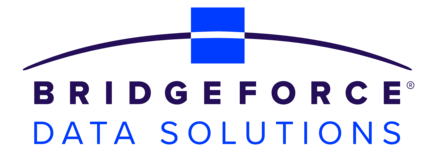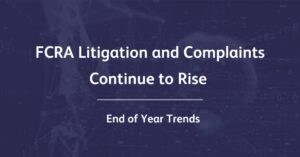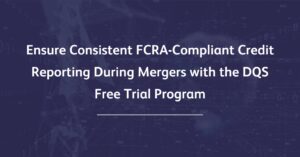In the complex world of credit dispute resolution, e-OSCAR stands out as a vital tool for efficient and compliant credit reporting. But what is e-OSCAR? Developed by four major consumer credit reporting agencies (CRAs), e-OSCAR standardizes the dispute handling process, benefiting consumers, lenders, and data furnishers alike. Today, it serves as a central solution for facilitating and standardizing the dispute resolution process. Short for Online Solution for Complete and Accurate Reporting, this web-based platform serves as a component of the credit reporting ecosystem, providing consumers, lenders, and creditors with a tool for handling credit reporting disputes. In this blog, we explore the ins and outs of e-OSCAR. We’ll examine its key features and functionalities, its role in the consumer lending industry, and its importance to consumers.
Intro to e-OSCAR
Developed by four of the consumer credit reporting agencies (Experian, Equifax, Innovis, and TransUnion), e-OSCAR enables CRAs and Data Furnishers to create and respond to consumer credit reporting disputes in a standardized format. The system mainly supports Automated Credit Dispute Verification (ACDV) and Automated Universal Dataform (AUD) forms processing, but also includes several processes related to disputes handling management and reporting.
Without e-OSCAR, resolving credit history disputes would be more labor-intensive and time-consuming. Data furnishers and CRAs would likely struggle to manage and respond to consumer disputes efficiently. Manual handling of disputes would also increase operational costs and compromise the reliability of credit information.
Regarding the overall financial landscape, e-OSCAR plays a crucial role in supporting consumers’ right to dispute furnished information. The processes enabled by e-OSCAR help achieve timely review and completion of consumer disputes.
It also contributes to compliance by providing a structured framework for managing disputes and documenting resolution efforts. This helps financial institutions demonstrate compliance with laws like the Fair Credit Reporting Act (FCRA) and Consumer Financial Protection Bureau (CFPB) regulations.
e-OSCAR is accessible as a web-based platform, which allows users to access it easily. The architecture also enables it to be tightly integrated with credit reporting systems used by data furnishers and CRAs via APIs.
Understanding what e-OSCAR is, and what it does, is necessary for understanding how its key features and functionalities work.
How e-OSCAR works
The e-OSCAR system works by facilitating the processing of credit report disputes between consumers, lenders, and CRAs. This process involves several steps:
Dispute Initiation
The dispute process most often begins when a consumer identifies what they believe is an error or discrepancy on their credit report. This can happen because of a mistake in data entry, identity theft, or fraud. It can also be due to outdated or incomplete information, mixing up credit files, or other reasons. Consumers can initiate the dispute via online dispute forms, written letters, or phone calls to the CRAs.
Data Furnisher Notification
The CRA then forwards the dispute information to the relevant data furnisher identified in the credit report. This is done by using one of the 29, three-digit dispute codes, available in e-Oscar. Examples of these are 001, not his/hers, or 010, indicating settlement or partial payments accepted. The data furnisher is then responsible for investigating the dispute and providing a response to the CRA by the Response Due Date indicated in the ACDV in e-OSCAR.
Efficient Processing
e-OSCAR plays a central role in the processing of credit reporting disputes. The system standardizes the dispute information format and facilitates the uniform exchange of data between the CRAs and data furnishers.
The first e-OSCAR-supported process is Automated Credit Dispute Verification (ACDV). ACDV involves the exchange of dispute information and supporting documentation between CRAs and data furnishers in a prescribed format. When furnishers respond to a dispute, e-OSCAR then transmits the response to the initiating CRA.
The second process, referenced briefly above, is the Automated Universal Dataform (AUD). AUD enables data furnishers to submit updates or corrections to consumers’ credit information directly to the CRAs. These submissions typically happen after completing reasonable investigations of direct disputes per FCRA requirements. They may also occur when a furnisher identifies a need to make out-of-cycle updates to its furnished trade lines. This helps ensure that any changes made to the credit report are reflected across all CRAs.
Resolution and Reporting
Once the dispute investigation is complete and a resolution is reached, e-OSCAR sends the furnisher’s ACDV response or AUD submission to the CRAs for them to process. If the dispute results in a request for a modification or deletion of information, the CRAs involved make the requested changes. They then send a communication to the consumer to advise them of the dispute investigation outcome.
Documentation and Audit Trails
Additionally, e-OSCAR maintains an archive of documentation and audit trails of communications and actions taken by the parties involved
Overall, e-OSCAR streamlines the dispute resolution process by, standardizing data exchange and facilitating communication between all involved.
Compliance
Another key aspect where e-OSCAR helps consumer lenders is the way it promotes compliance. By facilitating ACDVs and AUDs, e-OSCAR helps lenders complete disputes promptly to comply with the FCRA regulatory requirements.
Risk Management and Decision Making
Lastly, e-OSCAR contributes to risk management by helping lenders make more informed decisions. By enabling updates in credit reports, lenders can make better assessments of creditworthiness and more informed lending decisions.
Overall, e-OSCAR plays a key role in supporting efficient and compliant credit bureau dispute handling practices for consumer lenders, ultimately benefiting both themselves and consumers.
e-OSCAR FAQs
What is e-OSCAR?
e-OSCAR (Online Solution for Complete and Accurate Reporting) is a web-based, automated system used by data furnishers and credit reporting agencies (CRAs) to process and resolve consumer credit disputes in compliance with the Fair Credit Reporting Act (FCRA) and the Metro 2® format.
Who uses e-OSCAR?
e-OSCAR is used by credit reporting agencies (Equifax, Experian, TransUnion, and Innovis) and data furnishers, such as banks, lenders, and debt collectors, to manage and respond to consumer credit disputes.
How does e-OSCAR work for a consumer credit dispute?
When a consumer files a dispute with a CRA, the agency inputs the dispute into the e-OSCAR system. The system then automatically forwards a simplified dispute form to the data furnisher, who is required to investigate the claim and respond with updated information or a confirmation of accuracy.
What is the difference between an ACDV and an AUD?
An ACDV (Automated Consumer Dispute Verification) is a form initiated by a credit reporting agency to a data furnisher to verify a consumer dispute. An AUD (Automated Universal Dataform) is a form initiated by a data furnisher to a CRA to proactively update or correct a consumer’s credit history outside of their regular monthly reporting cycle.
Why is e-OSCAR important in consumer lending?
For consumer lenders, e-OSCAR is an essential tool for maintaining compliance with the FCRA. It provides a standardized and efficient way to handle the high volume of credit disputes, ensuring that any reported errors are addressed in a timely and consistent manner, which in turn helps maintain data accuracy.
e-OSCAR and Consumer Rights
With e-OSCAR playing a key role from the consumer lender’s point of view, it also plays an important role for the consumer. When a consumer submits a dispute, e-OSCAR ensures that the current credit report data is transmitted efficiently and securely to the CRAs.
According to FCRA section 611, a CRA is expected to provide a response within 30 days of the initial dispute being filed. This can be extended up to 15 additional days if the CRA receives more information during that period that is relevant to the investigation. Because of the communication built into e-OSCAR, CRAs and data furnishers can more effectively respond to messages. It also helps by quickly notifying furnishers of incoming disputes and informing the CRAs of dispute outcomes and resolutions. All these factors combined help with the overall speed of a response to the consumers.
Consumers should be aware though, that the CRA does have the option to terminate an investigation if they can reasonably determine that the dispute is irrelevant. This means that consumers must provide sufficient information to investigate the disputed information.
Future Trends and Development
With the great strides in consumer lending and reporting technologies over the years, there are still other needs in the disputes resolution process that can be addressed with additional solutions.
Room for Opportunities
e-OSCAR does a great job of facilitating the transmission of dispute data for a timely response. Opportunities do remain for a more holistic view of the origin of Metro 2® data quality errors and what’s required to resolve them.
With the new Data Quality Scanner Disputes Module from Bridgeforce Data Solutions, teams can uncover groundbreaking new insights into the end-to-end Metro 2® data quality journey. These insights allow all teams to improve the consistency and accuracy of dispute responses. The Data Quality Scanner Disputes Module can show you how often credit bureau disputes arrive with data inconsistency issues. These file-level insights include what was furnished and what was posted to each bureau. They then measure how often these issues are identified and fixed by disputes agents, as well as where dispute agents’ responses create new issues. Improving data quality and accuracy ensures compliance and positive consumer outcomes from the top down.
The new module also identifies strengths and educational opportunities at the dispute team and agent levels. With a breakdown view by specific dispute agents, teams can identify the conditions they are skilled at addressing. This view also reveals their blind spots and areas where new data issues might have been created.
Another Solution is Coming
Bridgeforce Data Solutions announced its first AI product for Credit Bureau Disputes is coming to market in 2025. Powered by Amazon Bedrock, this new AI product combines industry-leading Data Quality Scanner Furnishing and Disputes Modules results with indirect dispute data to provide robust insights for Dispute Agents.
With the help of large language models, agents will also be able to use AI chat features to ask questions about an account in plain English and receive a response. This will save agents significant time from having to look through numerous data sources to complete a reasonable investigation into each dispute. These new AI capabilities will also capture an automated audit trail of all the questions and answers provided during each dispute investigation.
Conclusion
e-OSCAR remains essential to the credit reporting landscape, offering an efficient, compliant way to handle consumer disputes. e-OSCAR for credit dispute resolution enhances the entire process with its standardized format and secure communication channels. This improvement spans every stage, from dispute initiation to final resolution. As technology advances, new features in e-OSCAR will continue supporting the credit ecosystem to benefit consumers and institutions alike.”
Now, there are opportunities to enhance this process and consumer outcomes with new technologies to help furnishers identify and resolve the root cause of furnishing discrepancies and improve their agents’ handling of disputes by providing a more holistic view of the origin of Metro 2® data quality errors and what’s required to resolve them.
Schedule time to talk with our experts today to learn more about the new Disputes Module, which is available now as part of Bridgeforce’s Data Quality Scanner Product Suite.



